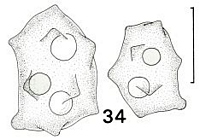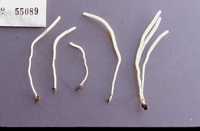|
 Clavaria tuberculospora Clavaria tuberculospora
BiostatusPresent in region - Indigenous. Endemic
Images (click to enlarge)
Caption: Fig. 34 Clavaria tuberculospora, spores. TENN no. 42410l. Scale bar = 5 µm. | 
Caption: Microfiche 1-27. Clavaria tuberculospora. TENN no. 43554. |
Article: Petersen, R.H. (1988). The clavarioid fungi of New Zealand. New Zealand Department of Scientific and Industrial Research, Bulletin 236: 170 pp. Wellington:.
Description: Fruit bodies up to 80 x 6 mm, simple clubs occurring singly or in small groups of up to three
individuals, occasionally connate or branched once, cylindrical to fusiform. Club white, buff
("pale cinnamon-pink") to pale dull yellow ("cartridge-buff"), opaque, often somewhat
longitudinally rugulose or fluted to sublacunose, expanding somewhat upward; apex
rounded. Stipe concolourous with club, tapering slightly downward, appearing shiny-silky,
inserted with a very small whitish mycelial patch. Taste and odour negligible.
Macrochemical reaction: FCL = negative.
Tramal hyphae hardly inflated, strictly parallel, thin-walled, hyaline, clampless; secondary
septa rare. Subhymenium well-developed, pseudoparenchymatous. Basidia 40-50 x 8-10 µm,
clavate, guttulate when young, bifurcate to clamped (obscurely so in mature hymenium),
persistent after spore discharge; sterigmata 4, stout, curved, ascending; contents
homogeneous to minutely multiguttulate; cystidia (or basidioles) broadly clavate, apically
thick-walled, hyaline, non-emergent.
Spores 6.1-7.9 x 4-5.4 µm (E = 1.21-1.64; Em = 1.45; Lm = 6.94 µm), angular-ellipsoid,
lobed to tuberculate-spiny, often with the protuberances only on the abaxial surface; contents
opalescent when fresh, homogeneous to 1-2 guttulate when dry; wall thin, easily collapsed
on drying; hilar appendix prominent.
Notes: The spores, although different in wall thickness and persistence, are very similar to those of
Ramariopsis helvola (Pers.) Pet. in outline only. Clavaria californica shares general fruitbody colour, bifurcate basidia,
ellipsoid and ornamented spores but spore ornamentation is
different.
The spores of Clavaria tuberculospora are thin-walled and collapse on drying, so turgid
spores are scarce in mounts. Of all the collections, TENN no. 42410 is by far the best, with
spores of normal shape. Some spores seem to be angular, others angular-tuberculate, and a
few seem to have these lobes attenuated into blunt spines. Such variation and shape have not
been reported in the genus before.
Basidia and "cystidia" are uniformly clamped or bifurcate in young hymenia, but many are
not so in thickened hymenia. This may be less common than observed, for basidial bases are
extremely difficult to observe in thickened hymenium, but several individuals were seen to
be simple-septate.
The structures described as cystidia are inconspicuous, often appearing empty, and are
broader than basidia, although no longer. Moreover, they are commonly transversely septate
in the lower half, and the apical wall is usually thickened (up to 0.7 µm thick). Whether they
are true cystidia or aberrant basidia cannot be ascertained. If correctly interpreted, they are
very common, outnumbering mature basidia.
|